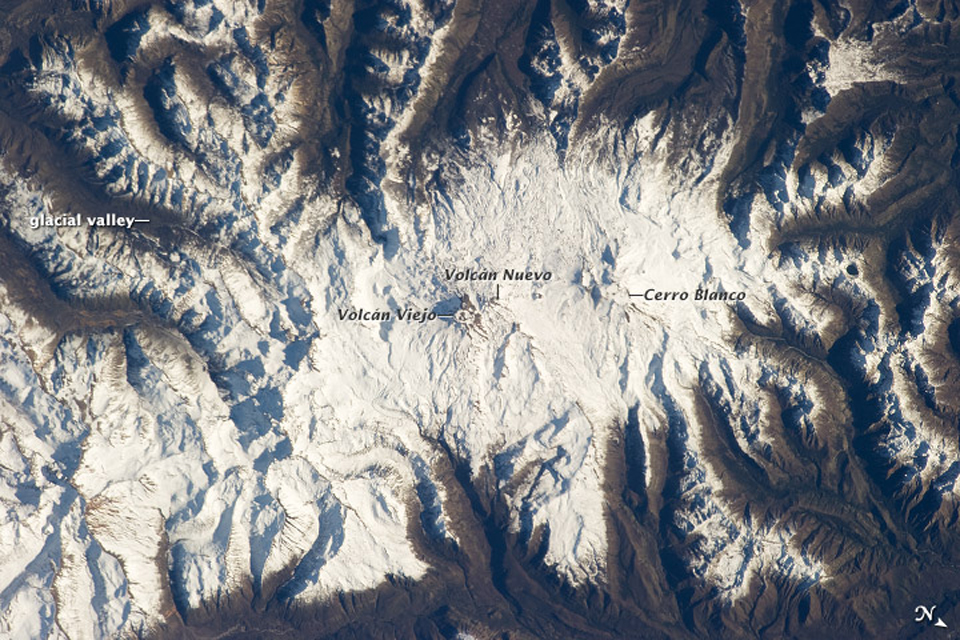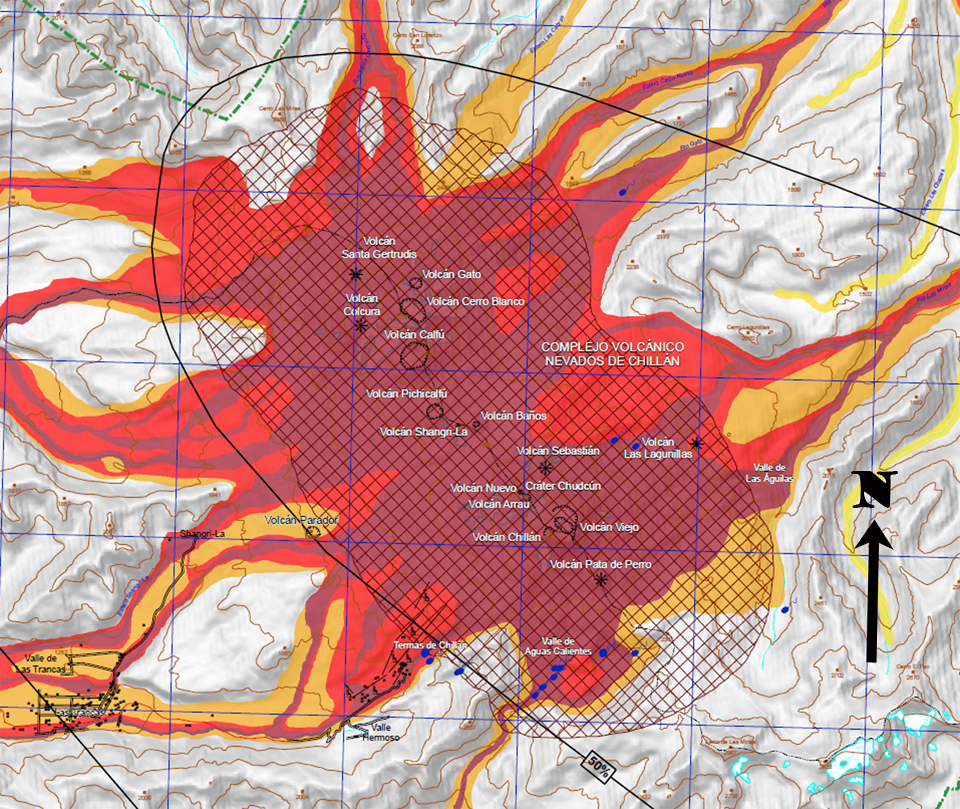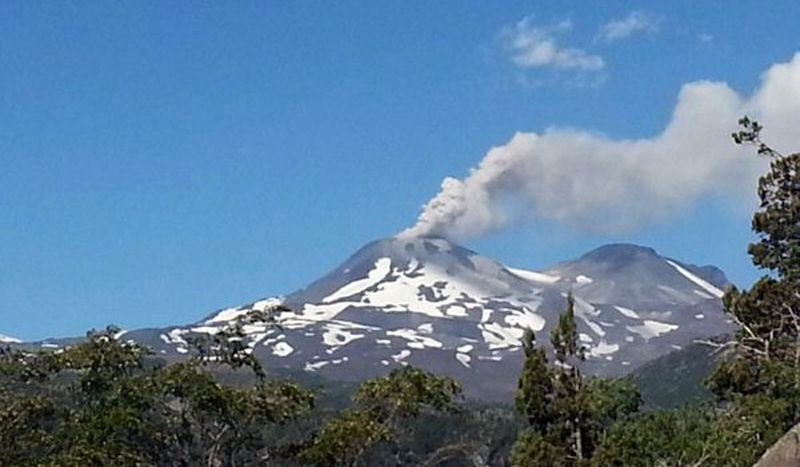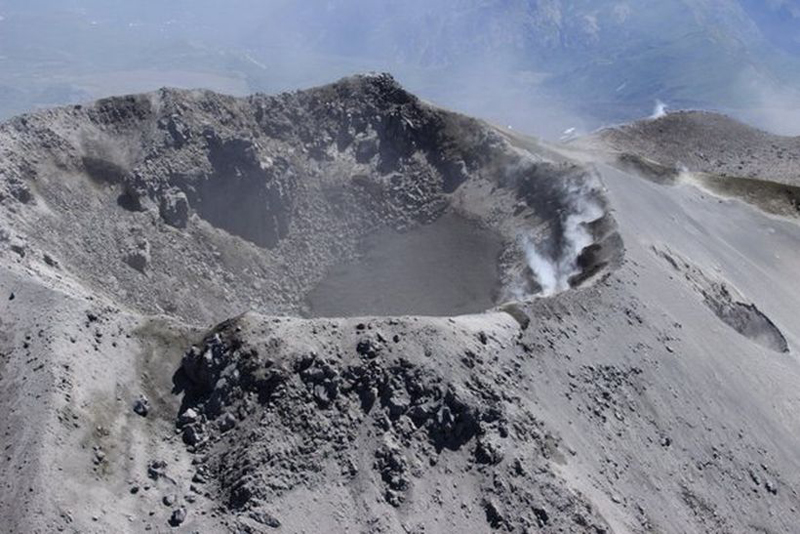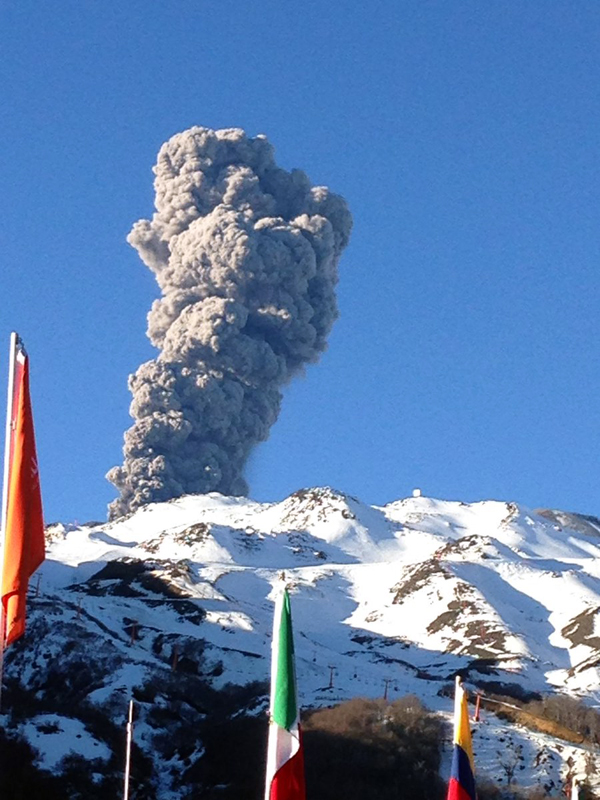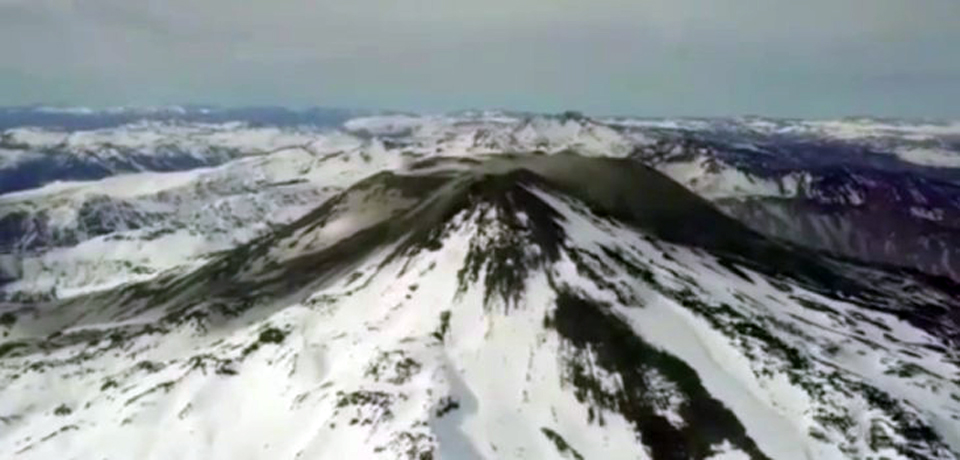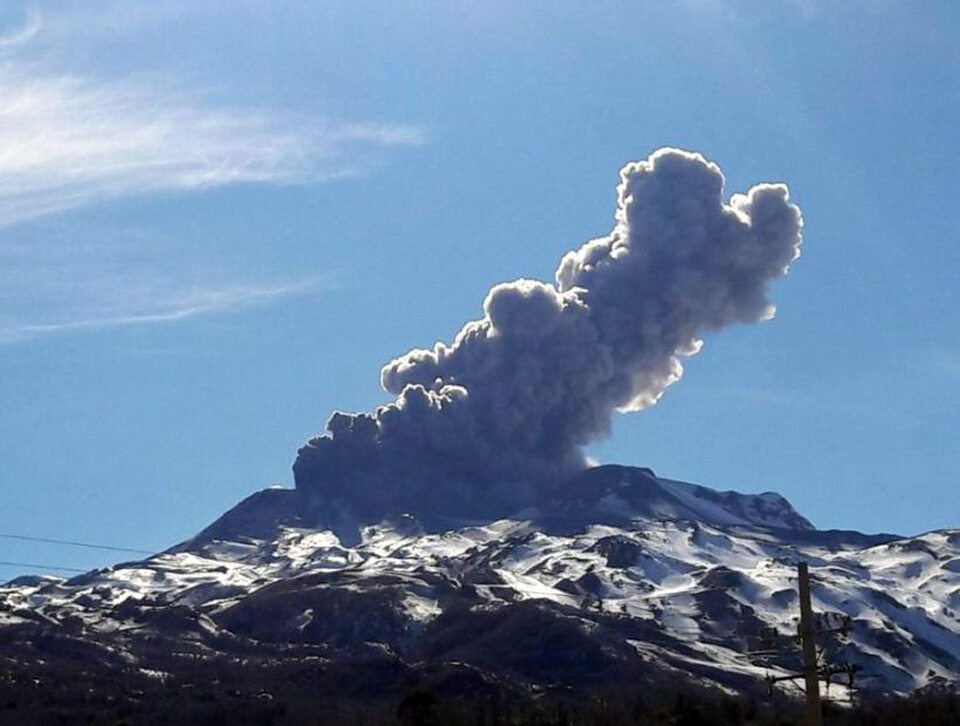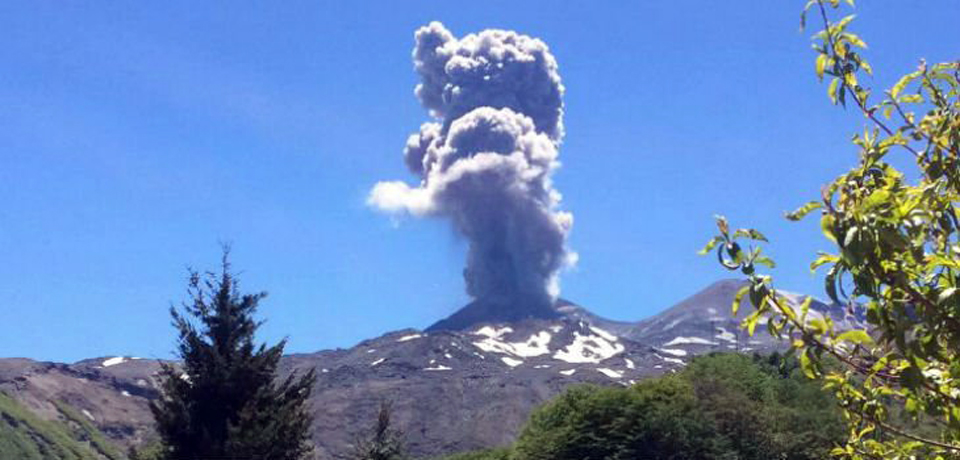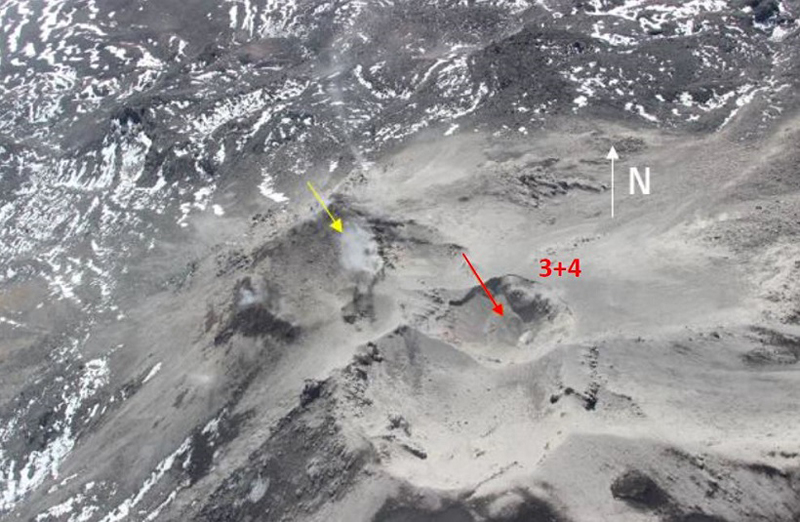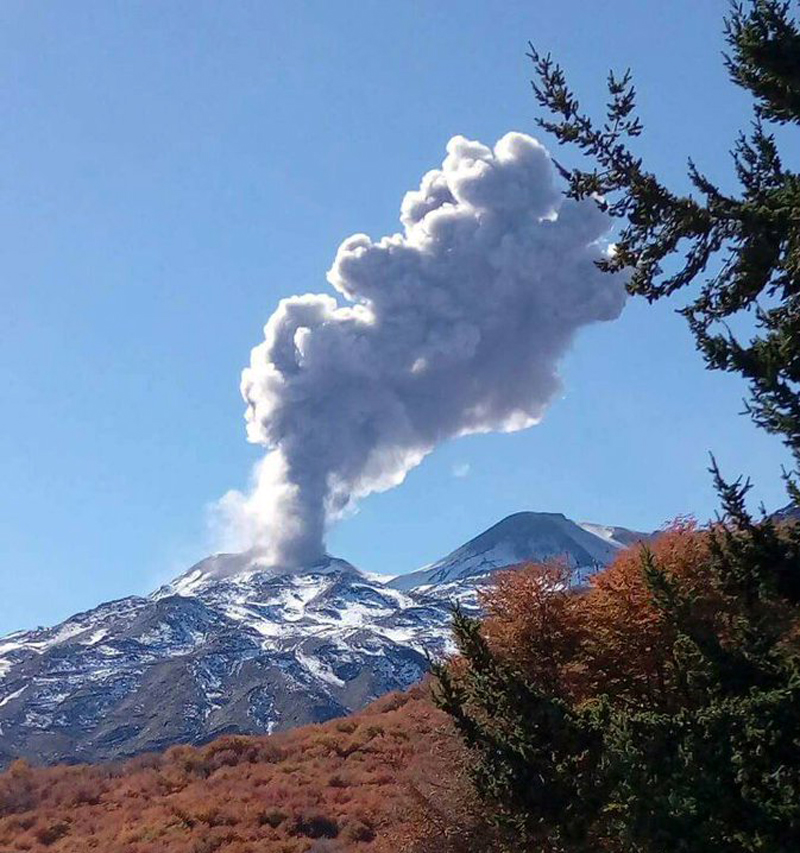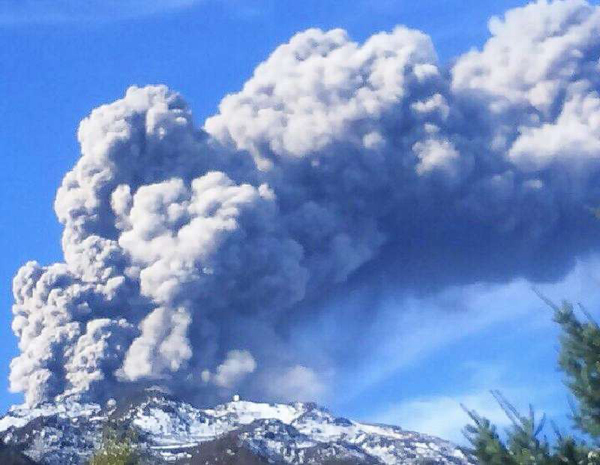Report on Nevados de Chillan (Chile) — October 2017
Bulletin of the Global Volcanism Network, vol. 42, no. 10 (October 2017)
Managing Editor: Edward Venzke.
Edited by A. Elizabeth Crafford.
Nevados de Chillan (Chile) Intermittent ash emissions from new craters along the E flanks of Volcáns Nuevo and Arrau persist through September 2017
Please cite this report as:
Global Volcanism Program, 2017. Report on Nevados de Chillan (Chile) (Crafford, A.E., and Venzke, E., eds.). Bulletin of the Global Volcanism Network, 42:10. Smithsonian Institution. https://doi.org/10.5479/si.GVP.BGVN201710-357070
Nevados de Chillan
Chile
36.868°S, 71.378°W; summit elev. 3180 m
All times are local (unless otherwise noted)
Nevados de Chillán, in the Chilean Central Andes, is a complex of late-Pleistocene to Holocene stratovolcanoes constructed along a NNW-SSE trend (figure 5). The Nuevo and Arrau craters, active during 1906-1945 and 1973-1986, respectively, are adjacent vents on the NW cone of a large stratovolcano complex 5 km SE of Cerro Blanco; the summit 1 km SE of Arrau is named Volcán Viejo (figure 6). A short eruption during August-September 2003 created a new fissure vent between the Nuevo and Arrau craters (BGVN 29:03, figure 3). Increased seismicity and fumarolic activity were recorded during December 2015, and a new eruption started with a phreatic explosion and ash emission on 8 January 2016 from a new crater on the E flank of Nuevo cones (BGVN 41:06). This report adds information about the beginning of the event and continues with activity through September 2017. Information for this report is provided by Chile's Servicio Nacional de Geología y Minería (SERNAGEOMIN) - Observatorio Volcanológico de Los Andes del Sur (OVDAS), Oficina Nacional de Emergencia - Ministerio del Interior (ONEMI), Corporación Ciudadana Red Nacional de Emergencia (RNE), and by the Buenos Aires Volcanic Ash Advisory Center (VAAC).
Ash emissions at Nevados de Chillán began on 8 January 2016, and were intermittent through September 2017. Four new craters emerged in a NNE trend along the flanks of Volcán Nuevo and Volcán Arrau; two eventually merged into a single 100-m-diameter crater. Most plumes were brief pulses of steam and ash that rose 200-300 m above the craters. Larger events sent a few plumes as high as 2.2 km above the summit (to 5.4 km altitude). Strong prevailing winds quickly dissipated most ash plumes. Periods of multiple small explosions lasted for 1-2 weeks, separated by periods of relative quiet characterized by only steam-and-gas emissions from the active craters and nearby fumarolic centers. The first observable incandescence at the craters was noted in early March 2016. Incandescent bombs were thrown 300 m above the craters during July and September 2016, and 500 m high during March-May 2017 when blocks also fell with 500 m of the craters.
Activity during 2016. After the first explosion with ash emissions on 8 January 2016, nine more pulses of ash were emitted the next day, and small sporadic emissions were reported in the following days (figure 7). OVDAS researchers flew over the volcano on 9 January and concluded that the explosions came from a new crater on the E slope of Volcán Nuevo, about 40 m from the edge of the crater. Researchers from the University of Cambridge who visited the site on 13 January observed continuous degassing at the new 20-m-wide crater. The Buenos Aires VAAC noted puffs of steam and gas dissipating a few hundred meters above the summit (at 3.7 km altitude) in satellite imagery on 16 January 2016. ONEMI reported an ash emission on 29 January that originated from the Arrau crater (see figure 6). During an overflight on 30 January, OVDAS researchers saw occasional explosions from the new crater at Nuevo, as well as activity at a new 30-m-diameter crater about 50 m from the Arrau crater on its NE flank (figure 8). Several fumaroles were also identified on the E flank of Arrau crater.
During the first two weeks of February 2016, there were 175 episodes of discrete tremor; webcams recorded explosions that ejected material from both craters. The Buenos Aires VAAC reported a brief ash emission on 3 February that dissipated quickly near the summit. During an overflight on 11 February coordinated with ONEMI, scientists identified a third crater, which created a 150-m-long NNE trend with the other two active craters identified during January. During the second half of February, emissions consisted mostly of steam plumes rising no more than 300 m above the crater.
Activity during March 2016 was characterized by steam plumes rising from the active craters; on 3 March, however, a small ash emission was observed. Incandescence was observed in the crater area on the night of 9 March. SERNAGEOMIN reported the beginning of an episode of long-period (LP) seismicity on 18 March, with a pulsating pattern of 3-4 events per minute. During the second half of March, LP and tremor activity was associated with ash emissions. Notably, a low-energy tremor on 30 March lasted for several hours, and concurrently a dense ash plume rose 200 m.
Ash emissions were observed on 7, 8, 9, 18, and 19 April 2016. Plumes were reported rising 400 m on 8 April, and 200 m on 18 and 19 April. Incandescence was observed along with the ash on 18 April. A significant explosion on 9 May 2016 generated an ash plume that rose 1,700 m above the summit (figure 9). The Buenos Aires VAAC reported the ash plume at 3.9 km altitude (700 m above the summit) drifting SE. An overflight by OVDAS on 9 May confirmed the presence of three active craters on the active summit, with the central one having enlarged by 50% since the previous overflight on 11 February. Only pulsating steam emissions were observed in the webcam during the remainder of May and June 2016.
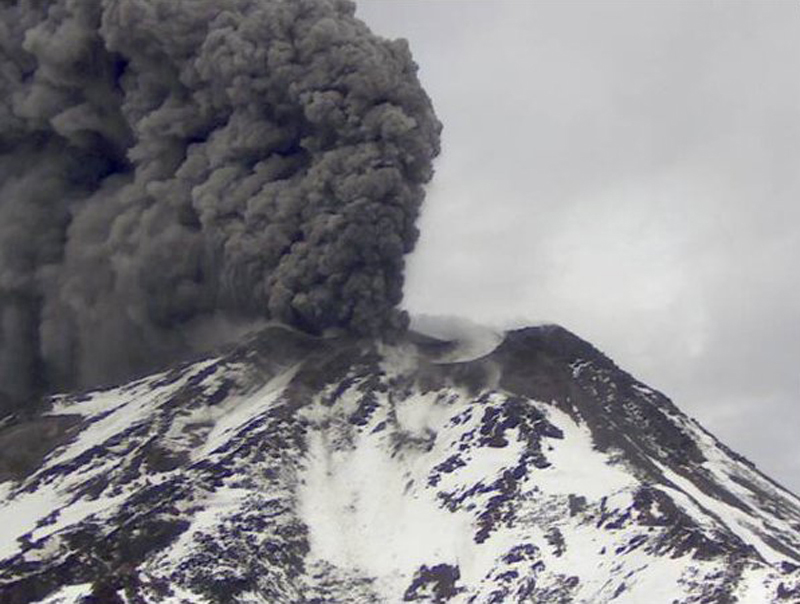 |
Figure 9. An ash plume rises 1,700 m above the active crater area at Nevados de Chillán after an explosion in the early morning of 9 May 2016. Courtesy of SERNAGEOMIN. |
Only steam emissions were reported during the first half of July 2016, but on 21 July an ash-laden emission sent incandescent bombs 300 m above the crater. The Buenos Aires VAAC reported that the webcam showed an ash emission to 3.4 km altitude (200 m above the craters) that day. Webcam Images obtained on 25 July showed debris from an explosion scattered 300 m down the NE flank. During the next few days, ash emissions were inferred from the seismic tremors, but weather conditions prevented direct observations.
During the first two weeks of August 2016, 14 explosions were recorded from the new craters on the E flanks of Nuevo and Arrau. The largest explosion, on 8 August, sent an ash plume 2 km above the crater, according to SERNAGEOMIN (figure 10). The Buenos Aires VAAC reported brief ash emissions on 1, 4, 8, and 9 August at altitudes of 3.7, 3.4, 4.3, and 3.7 km altitude, respectively. Fresh ashfall was visible on the flanks during a flyover on 12 August (figure 11). On the few days when the weather permitted observation of the summit during the remainder of the month, only steam plumes were observed rising no more than 400 m above the crater.
Pulsating steam plumes, interrupted by periodic ash emissions, were typical during September 2016. During the first two weeks of the month, 37 recorded explosions were characterized by a high concentration of particulate material. The largest explosion, during the evening of 1 September, generated incandescent bombs for 20 minutes. Incandescence was observed during nighttime explosions a number of times. The Buenos Aires VAAC noted a pilot report of an ash cloud moving SW at 5.2 km altitude on 2 September. They also reported a weak emission of steam and gas with possible diffuse ash visible in the webcam that day. Another pilot report on 6 September indicated an ash cloud moving NE at 6.4 km altitude from a brief but intense emission event around 1420 UTC (figure 12). SERNAGEOMIN noted in their late September report that there had been six explosive episodes since January 2016, with the latest one that occurred during 1-10 September being the strongest.
Explosive activity was recorded on 3, 7, and 8 October 2016 by SERNAGEOMIN; The events were low-energy episodes that emitted small quantities of ash. The Buenos Aires VAAC noted a pilot report on 3 October of an ash cloud moving SE near the summit. It was visible in the webcam but not in satellite imagery, and dissipated quickly. The tallest emission of those days rose to 300 m above the crater on 7 October. During an overflight on 22 October, the continued presence of the three craters along the E flanks of Nueva and Arrau reported previously was confirmed. In addition, the existence of a fourth crater was noted along the same trend as the others. The Buenos Aires VAAC noted ash emissions on 26 and 28 October rising to between 3.7 and 4.3 km altitude and dissipating quickly near the summit.
Seismic activity during the first half of November 2016 included 17 explosions from the active craters. An explosion on 18 November generated an ash plume that rose 1.2 km (figure 13). The Buenos Aires VAAC noted a pilot report of possible ash emissions between 4.6 and 6.1 km altitude on 17 and 27 November, although neither were identified in satellite data.
Explosions associated with LP and tremor seismicity continued into December 2016. There were 14 explosive seismic events during the second half of the month, reported by SERNAGEOMIN. The largest occurred on 28 December. The Buenos Aires VAAC noted pilot reports of ash emissions that dissipated near the summit on 13, 28, and 29 December.
Activity during January-September 2017. Explosions related to LP and tremor seismicity increased again on 5 January 2017. The Buenos Aires VAAC reported a dark fumarolic plume drifting E at 4.5 km altitude on 6 January that was observed by a pilot and in the webcam. On 11 and 13 January, the webcam showed sporadic puffs of ash that dissipated very quickly. The largest event occurred on 15 January; the Buenos Aires VAAC reported a narrow plume of ash in satellite imagery at 3.9 km altitude moving W. The webcam also showed sporadic and small puffs that dissipated quickly. An event on 16 January produced an emission that rose 700 m above the crater according to SERNAGEOMIN. This was the last LP-associated explosion of the month. Scientists on a 20 January overflight noted low-intensity steam plumes from the Nuevo and Arrau craters, and from the Chudcún crater which formed in 2003 between them (see figure 6). Yellow and ocher-colored areas, indicating the presence of precipitated sulfur, were visible around the fumaroles and craters.
Low-level degassing rising less than 200 m above the crater was the only surface activity observed during February 2017. A new stage of explosive activity began on 7 March 2017 with emissions that rose as high as 300 m above the crater. The Buenos Aires VAAC noted a pilot report of an ash plume at 3.7 km altitude, and a short-lived puff of ash seen in the webcam. On 11 March, eight explosions sent incandescent blocks up to 0.5 km from the active craters, and emissions rose to 500 m above the crater. Another series of eight explosions on 14 March produced incandescent material and sent an ash plume 1.5 km above the craters. The Buenos Aires VAAC reported intermittent emissions rising up to 4.9 km altitude that day, followed by continuing steam emissions. The following day they noted a small plume near the volcano at 3.9 km altitude visible in satellite data.
During a flyover on 15 March, OVDAS scientists noted that two of the craters (craters 3 and 4) had merged into a single crater 100 m in diameter (figure 14). They also observed five explosions within the space of an hour, the highest resulting plume rose 900 m above the active crater. Webcam images during 16-17 March showed ash emissions rising to 2 km above the crater. The Buenos Aires VAAC reported an ash emission visible in satellite imagery at 5.5 km altitude moving SW on 16 March. For the remainder of the month, only weak degassing under 200 m above the crater was observed. Beginning on 24 March, low-level incandescence at night was reported for the rest of the month.
Between 1 and 12 April 2017, there were 56 intermittent explosions marking a new phase of activity according to SERNAGEOMIN. The webcams around the complex imaged emissions up to 3 km above the crater throughout the month. The Buenos Aires VAAC reported sporadic emissions of ash visible in the webcam on 3 and 6-8 April. A faint emission at 3.7 km altitude was spotted in satellite imagery on 10 April. From 16 to 30 April, there were 79 intermittent explosions recorded. During dusk and dawn, incandescent material was observed traveling 600 m down the flanks, with some episodes lasting for 60 minutes. The Buenos Aires VAAC reported a brief ash emission and incandescent material visible in the webcam on 17 April, and sporadic ash emissions that rose to 3.9 km altitude on 21, 29, and 30 April (figure 15).
Nine intermittent explosions occurred between 1 and 11 May 2017. The webcams showed emissions from the explosions rising generally 300 m above the craters according to SERNAGEOMIN. Intermittent explosions increased again during 27-31 May. Emissions rose to 1.5 km above the craters and incandescent blocks could be seen traveling 600 m down the flank. Periods of constant incandescence lasted for 30 minutes.
This explosive episode continued into June 2017, with 23 intermittent explosions between 1 and 5 June. The largest emission event on 5 June sent a plume 2.2 km above the craters (figure 16). The Buenos Aires VAAC observed the ash plume at 4.6 km altitude in satellite imagery. During 6-15 June, only steam emissions rising to 300 m were reported. Intermittent explosions on 20, 22, 25, and 26 June produced plumes that rose only 200 m above the craters; cloudy weather prevented observation from the webcams during these events.
No explosive events were observed in the webcams during the first half of July 2017; only steam plumes rising 200 m were reported. A single low-energy explosion was recorded on 31 July; the emission rose to only 100 m above the crater. During August 2017, there were 83 intermittent explosions associated with ash emissions recorded by SERNAGEOMIN. The emissions rose to about 300 m above the active craters; a few larger emissions rose 1,000 m. The Buenos Aires VAAC noted a pilot report of ash emissions on 17 August; the webcam captured a brief emission that dissipated rapidly.
About 150 intermittent explosions were reported during September 2017. The highest plumes, generally composed of steam and ash, rose 2,000 m above the craters. The Buenos Aires VAAC observed a narrow plume of ash in satellite imagery moving N at 3.9 km altitude and dissipating rapidly on 15 September, and a similar plume moving SE near the summit on 26 September 2017.
Reference: Orozco, G.; Jara, G.; Bertin, D. 2016. Peligros del Complejo Volcánico Nevados de Chillán, Región del Biobío. Servicio Nacional de Geología y Minería, Carta Geológica de Chile, Serie Geología Ambiental 28: 34 p., 1 mapa escala 1:75.000. Santiago.
Geological Summary. The compound volcano of Nevados de Chillán is one of the most active of the Central Andes. Three late-Pleistocene to Holocene stratovolcanoes were constructed along a NNW-SSE line within three nested Pleistocene calderas, which produced ignimbrite sheets extending more than 100 km into the Central Depression of Chile. The dominantly andesitic Cerro Blanco (Volcán Nevado) stratovolcano is located at the NW end of the massif. Volcán Viejo (Volcán Chillán), which was the main active vent during the 17th-19th centuries, occupies the SE end. The Volcán Nuevo lava-dome complex formed during 1906-1945 on the NW flank of Viejo. The Volcán Arrau dome complex was then constructed on the SE side of Volcán Nuevo between 1973 and 1986, and eventually exceeded its height. Smaller domes or cones are present in the 5-km valley between the two major edifices.
Information Contacts: Servicio Nacional de Geología y Minería, (SERNAGEOMIN), Observatorio Volcanológico de Los Andes del Sur (OVDAS), Avda Sta María No. 0104, Santiago, Chile ( URL: http://www.sernageomin.cl/); Oficina Nacional de Emergencia - Ministerio del Interior (ONEMI), Beaucheff 1637/1671, Santiago, Chile (URL: http://www.onemi.cl/); Corporación Ciudadana Red Nacional de Emergencia (RNE, Citizen Corporation National Emergency Network), Avda. Vicuña Mackenna Nº3125, San Joaquín, Santiago de Chile, Chile (URL: http://www.reddeemergencia.cl/); Buenos Aires Volcanic Ash Advisory Center (VAAC), Servicio Meteorológico Nacional-Fuerza Aérea Argentina, 25 de mayo 658, Buenos Aires, Argentina (URL: http://www.smn.gov.ar/vaac/buenosaires/inicio.php?lang=es).


